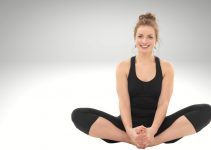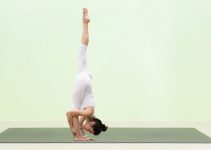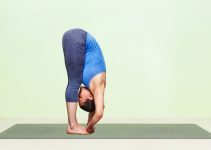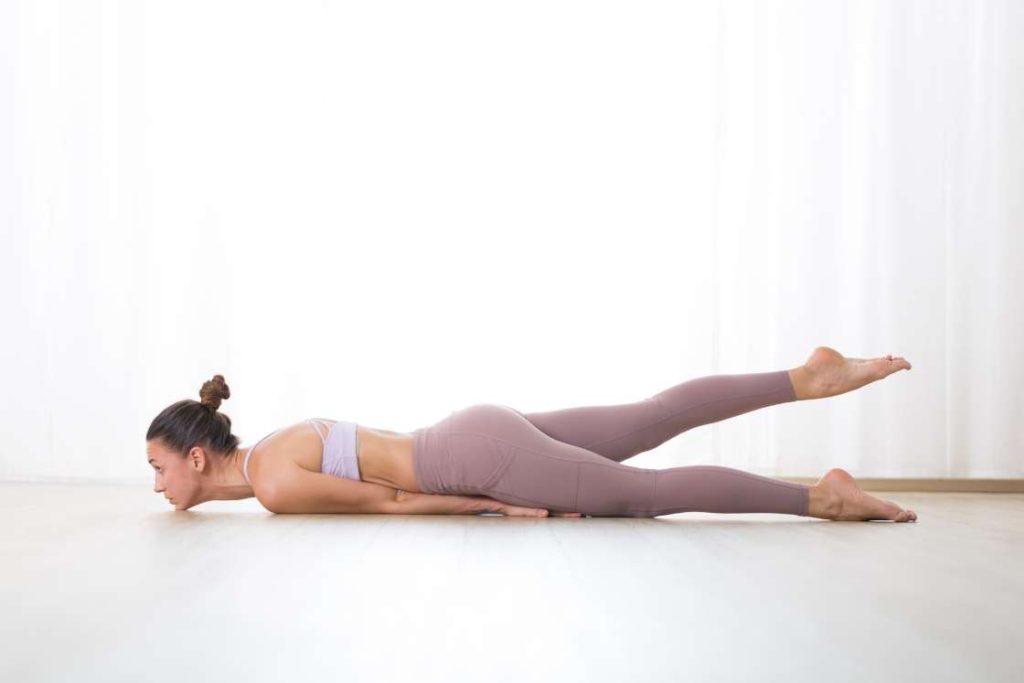
For all who want to stay in shape to flaunt their curves, Ardha shalabhasana is an easy stretching posture. Its tension-relieving effects around the pelvic region are also something that catches the interest of the yogis.
Ardha shalabhasana can be assumed by lying down in a prone position. Then during the posture, the entire torso and the chin touch the floor with one leg remains lifted.
This posture stretches and strengthens the hip, pelvic, and psoas muscles. It majorly benefits the lower body by acting as an excellent hip-opener and also improves the legs’ flexibility.
Ardha Shalabhasana Meaning
Ardha Shalabhasana is a Sanskrit name given to this posture containing three root terms, ardha+ shalabha+ asana.
- The term “Ardha” refers to “half”
- “Shalabha” means “locust”
- “Asana” is “body posture”
While holding this pose the body resembles that of the locust, similar to the basic pose, shalabhasana from where it has been derived. The only difference here is, it involves lifting of only one leg at a time which explains the prefix “ardha” and the name, ardha shalabhasana.
It is also known by the names like Half-Locust Pose or Locust Pose Torso On Floor One-Leg Up.
Ardha Shalabhasana Practice Guide
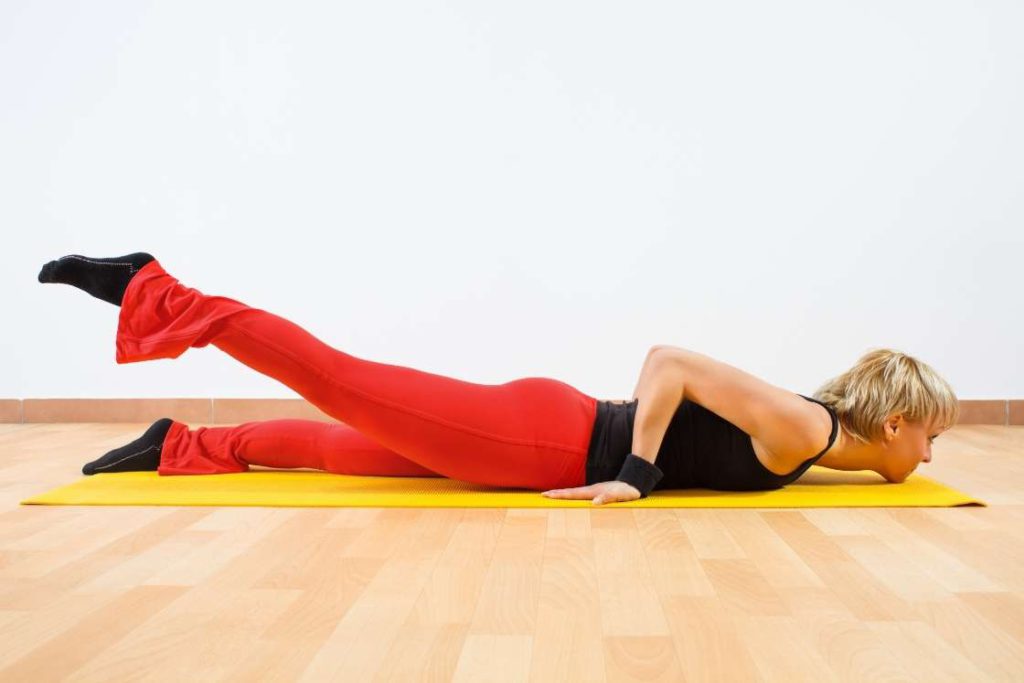
Contraindications
- This pose must be avoided by women during pregnancy and menstruation.
- Cardiac patients or people with high blood pressure must also skip ardha shalabhasana.
- Do not try this asana if you are suffering from a hernia.
- People with troubled back or slipped disc must not practice this pose.
- It is not recommended for people having lower abdomen issues, appendix, etc.
- Avoid this pose if you’ve had a recent injury in the back or legs.
Preparatory Pose
To prepare the body for ardha shalabhasana, Bhujangasana (Cobra Pose) is the most helpful one.
Ardha Shalabhasana Steps
- Begin with lying down in a prone position.
- Keep your hands under your thighs with palms facing either downward or hands clenched.
- Ensure to keep the legs straight throughout the practice.
- Extend your neck muscles forward and place the chin on the floor. Your neck muscles and nerves must feel the stretch.
- Muster the strength from the back muscles and inhale to lift the left leg as high as possible.
- The right leg and the entire body remain on the floor.
- Hold the final position as such breathing deeply for 10-15 seconds
- Release the pose by exhaling gradually to lower your left leg back to the floor.
- Repeat the same steps raising the right leg to complete one round.
- Similarly, perform 3-5 rounds and then relax.
Follow-up poses
In any yoga session, ardha shalabhasana is followed by Shalabhasana (Locust Pose).
Precautions
- While one leg is lifted during the pose, the body should not feel any strain.
- Do not bend the knees while holding Ardha shalabhasana.
- Ensure the chin is in contact with the floor throughout the pose.
- Keep the torso to the floor and do not twist or tilt the pelvis.
Beginners tips
While performing half-locust pose, following tips will enhance your practice
- Always lift your left leg first for Ardha shlabhasana, this will exert pressure on the right side of the abdomen. It leaves massaging effects on the ascending colon of the large intestine.
- This is followed by raising the right leg to pressurize the descending colon.
- These two consecutive moves in this sequence help in promoting intestinal peristalsis.
- Try to focus on your breaths and sync it with the movements.
- On a physical level, bring your awareness to the lower back, abdomen, and heart. However, on a spiritual level draw your attention to the Swadhisthana Chakra.
Props and Modifications
Use following props to modify the ardha shalabhasana’
- Blanket – Place a folded blanket under the pelvis before attempting the leg lifting to attain ardha shalabhasana. It will help to eliminate any strain on the lower back.
- Bolster – You can keep a bolster under the thighs instead of using the folded blanket to ease the pose.
Ardha Shalabhasana Variations
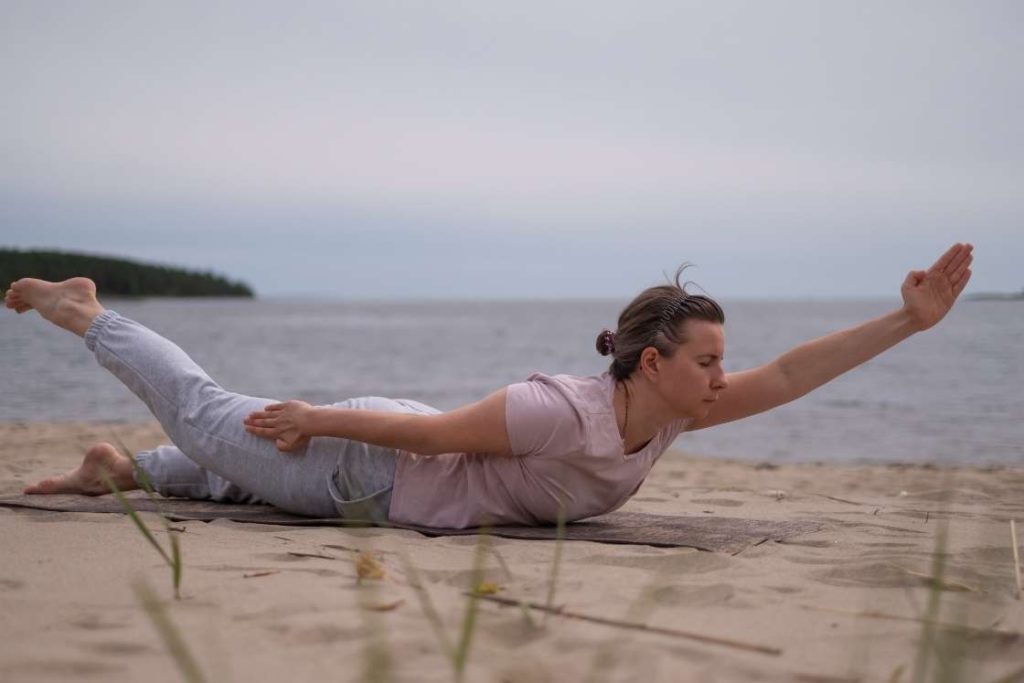
By adding following movements in the basic half locust pose, these variations can be performed;
1. Ardha shalabhasana II (asymmetrical)
In this variation, the arms are placed asymmetrically, hence the name. For this, lying down on your belly extend your right arm over your head with your palm facing to the left. Place the left arm by the side with palm facing towards the body.
Now, lift the left leg, right arm, head, and chest. Let the torso and right leg remain on the floor while holding the pose. Don’t forget to repeat it to the alternate side.
2. Ardha Shalabhasana II (symmetrical)
This variation can be assumed by taking Advasana (opposite of Shavasana) as the base pose and raising the alternative arm along with the lifted leg. The lifting of the leg and arm must be done simultaneously.
Here also, the first round is completed by repeating the above steps by switching the leg and arm. It is recommended to perform up to five rounds. This variation is recommended for beginners with a stiff back.
3. Ardha Shalabhasana arms-forward
For this variation assume Advasana by keeping both arms extended over the head while lying down on your belly. Now raise your left leg bent on the knee. Also raise both your arms, head, and chest off the floor.
4. Ardha Shalabhasana arms by the sides
This variation is generally preferred by beginners. For this all the steps remain the same, only the arms are placed by the sides of the body and not under the thighs. You can form a fist with the hands while lifting the leg.
Therapeutic Applications
- Ardha Shalabhasana acts as an effective reliever for people suffering lower back pain [efn_note] Role of yoga in the clinical management of low back pain http://www.ayurline.in/index.php/ayurline/article/download/313/436/ [/efn_note] and sciatica [efn_note] STUDY OF EFFECT OF SELECTIVE YOGATECHNIQUES IN THE MANAGEMENT OF GRIDHRASI-SCIATICA https://ayushdhara.in/index.php/ayushdhara/article/view/445/378 [/efn_note]
- Half locust pose helps in getting rid of constipation.
- Patients of diabetes [efn_note] EFFECT OF YOGA ON BIO- MARKERS LINKED WITH DEVELOPMENT OF DIABETES https://www.recentscientific.com/sites/default/files/Download_436.pdf [/efn_note] also experience beneficial results with its consistent practice.
Ardha Shalabhasana Benefits
1. Strengthens lower back – To hold ardha shalabhasana the leg is lifted using the back muscles. It stretches the back muscles and releases any trapped tension. Thus, the lower back muscles are well exercised and strengthes the lower back.
2. Tones the leg muscles – Ardha shalabhasana tones the thighs and buttocks. It helps in losing any extra fat layer deposited around these regions. It transforms the practitioner into a better shape.
3. Improves shoulder and neck strength – This posture involves stretching the neck and shoulder muscles. It provides improved flexibility and strength to the practitioner.
4. Enhances spine flexibility – Half locust pose stretches the entire back and stimulates the spinal muscles. As the legs are stretched backward and the neck in the forward direction. This makes the spine flexible.
5. Improves blood circulation – Ardha shalabasna stimulates the pelvic region which improves the flow of blood in this region. Due to improved blood circulation, it relaxes the pelvic floor muscles.
6. Stimulates reproductive system – This asana enables the flow of blood towards the pelvis region and internal organs. It improves the efficiency of the reproductive system.
7. Improves concentration – This pose stimulates the nervous system as awareness is drawn to coordinate the muscle movement with breathing patterns. This helps in enhancing the concentration power of the brain.
8. Improves the Endocrine system – Ardha Shalabhasana also stimulates the adrenal and thyroid glands. It improves the functioning of the endocrine system. The endocrine system regulates the glands of the body to secrete essential hormones properly.
9. Aids in better digestion – This pose massages the abdominal region and stimulates the internal organs. Hence, this pose is beneficial in facilitating the digestion process and keeps the practitioner away from digestive disorders.
Conclusion
Practice ardha shalabhasana to get energizing effects and a flexible body similar to the locust who can make large leaps due to these abilities.
Ardha shalabhasana has a lot to offer including the therapeutic benefits. Therefore, help yourself to assume the posture using the above practice guide.
